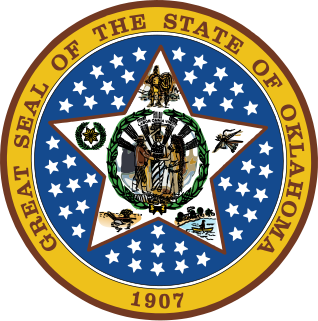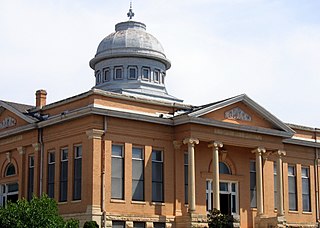
Mangum is a city in and county seat of Greer County, Oklahoma, United States. The population was 3,010 at the 2010 census. It was originally part of Old Greer County in the Texas panhandle. The community was named for A. S. Mangum, who owned the land on which the town was founded in 1882. It became part of Oklahoma Territory in 1896, and thus part of the state of Oklahoma on November 16, 1907.

Guthrie is a city and county seat in Logan County, Oklahoma, United States, and a part of the Oklahoma City Metroplex. The population was 10,191 at the 2010 census, a 2.7 percent increase from the figure of 9,925 in the 2000 census.

The Oklahoma State Capitol is the house of government of the U.S. state of Oklahoma. It is the building that houses the Oklahoma Legislature and executive branch offices. It is located along Lincoln Boulevard in Oklahoma City and contains 452,508 square feet of floor area. The present structure includes a dome completed in 2002.
The Oklahoman is the largest daily newspaper in Oklahoma and is the only regional daily that covers the Greater Oklahoma City area. The Alliance for Audited Media lists it as the 59th largest U.S. newspaper in circulation. The Oklahoman experienced a drastic 42% circulation decline from 2007 to 2012. The Oklahoman has been published by Gannett owned by Fortress Investment Group and its investor Softbank since October 1, 2018. On November 11, 2019, GateHouse Media and Gannett announced GateHouse Media would be acquiring Gannett and taking the Gannett name. The acquisition of Gannett was finalized on November 19, 2019. Copies are sold for $2 daily or $3 Sundays/Thanksgiving Day; prices are higher outside Oklahoma and adjacent counties.

The Oklahoma Historical Society (OHS) is an agency of the government of Oklahoma dedicated to promotion and preservation of Oklahoma's history and its people by collecting, interpreting, and disseminating knowledge and artifacts of Oklahoma. The mission of the OHS is to collect, preserve, and share the history and culture of the state of Oklahoma and its people.

The Guthrie Historic District (GHD) is a National Historic Landmark District encompassing the commercial core of Guthrie, Oklahoma, US. According to its National Historic Landmark Nomination it is roughly bounded by Oklahoma Avenue on the north, Broad Street on the east, Harrison Avenue on the south, and the railroad tracks on the west; it also includes 301 W. Harrison Avenue. The National Historic Landmarks Program on-line document describes the boundaries as "14th Street, College Avenue, Pine Street and Lincoln Avenue. One building, the Logan County Courthouse, is at 301 E. Harrison Avenue, outside the main boundaries of the GHD," This article relies on the former source, which is more detailed. According to the 1998 nomination, the proposed district covered 31 acres (13 ha). The nomination included 112 resources, classed as 69 contributing buildings, 38 non-contributing buildings, 1 non-contributing structure and 3 noncontributing objects. It was declared a National Historic Landmark in 1999 for its historic significance as the first capital of the Oklahoma Territory and of Oklahoma.

The Manhattan Building, also known as the Phoenix Building or the Phoenix-Manhattan Building, is a historic skyscraper in Muskogee, Oklahoma. The building has eight stories, containing 50,957 square feet (4,734.1 m2) of floor space, and was initially intended as the home of the Manhattan Construction Company, reportedly Oklahoma's first incorporated business. It was built in 1911 with a reinforced concrete frame and gray brick cladding. These walls were lined with windows to provide light and ventilation, the latter were essential to cope with torrid Oklahoma summers in an era when hardly any large buildings had air conditioning. It was built in Sullivanesque architectural style, with two-story columns flanking the entrance and a second floor cornice with dentils. The entry opened into a two-story lobby whose walls were covered with tile. A rooftop penthouse was added in 1957. The Manhattan Building was added to the National Register of Historic Places for architectural significance in 1983.

The following is an alphabetical list of articles related to the U.S. state of Oklahoma.

The following outline is provided as an overview of and topical guide to the U.S. state of Oklahoma:

Founders Tower is a Googie-style residential skyscraper located northwest of downtown Oklahoma City in the U.S. state of Oklahoma. The tower is one of the most well-known landmarks in the city skyline. It has a height of 275 feet (84 m) and 20 stories, with a restaurant called 360 featuring 360-degree panoramic views of Oklahoma City on its top floor.

The Heritage, formerly known as the Journal Record Building, Law Journal Record Building, Masonic Temple and the India Temple Shrine Building, is a Neoclassical building in Oklahoma City, Oklahoma. It was completed in 1923 and listed on the National Register of Historic Places in 1980. It was damaged in the 1995 Oklahoma City bombing. It houses the Oklahoma City National Memorial Museum in the western 1/3 of the building and The Heritage, a class A alternative office space, in the remaining portion of the building.
The Montana Central Railway was a railway company which operated in the American state of Montana from 1886 to 1907. It was constructed by James Jerome Hill's St. Paul, Minneapolis & Manitoba Railway, and became part of the Great Northern Railway in 1889.

The Carnegie Library in Guthrie, Oklahoma, is a building at 406 East Oklahoma Avenue. Constructed in 1901, It was the second Carnegie-funded library built in Oklahoma and the oldest one still in existence. The Guthrie library opened on May 20, 1903, It remained Guthrie's main library until 1972, when the city decided to tear it down and build a new facility in its place. Fred Pfeiffer, a local philanthropist, offered to fund a new structure next door to the Carnegie Library, if the old building were kept intact. The city accepted his offer, and gave the building to the Oklahoma Historical Society. It was listed on the National Register of Historic Places in 1971. The old building is now part of the Oklahoma Territorial Museum. Oklahoma Territorial Museum opened Nov. 13, 1973.
The Oklahoma Times was a newspaper published in Oklahoma City.
The Herald was a weekly trade union magazine published in Adelaide, South Australia between 1894 and March 1910; for the first four years titled The Weekly Herald. It was succeeded by The Daily Herald, which ran from 7 March 1910 to 16 June 1924.
The following is a timeline of the history of Oklahoma City, Oklahoma, US.
The following is a timeline of the history of the city of Tulsa, Oklahoma, United States.

The First National Bank and Trust Company Building is a historic building located within the Perry Courthouse Square Historic District at the corner of 6th Street and Cedar Street in Perry, Oklahoma. It was built in 1902 and listed on the National Register of Historic Places (NRHP) in 1979.

Joseph Pierre Foucart (1848–1917) was a prominent architect during the opening of the Oklahoma Territory. The city of Guthrie, Oklahoma's skyline is dominated by buildings designed by him.

The Oklahoma Publishing Company Building, also referred to as the Daily Oklahoman Building, is an historic structure on 4th and Broadway in Oklahoma City. It was built for the publishing company behind The Oklahoman. It was designed by Solomon Layton and built in 1909 after the paper's previous building was destroyed by fire. It is listed on the National Register for Historic Places. Layton also designed the Oklahoma State Capitol, governor's mansion, numerous county courthouses, public schools, and other significant structures.


















